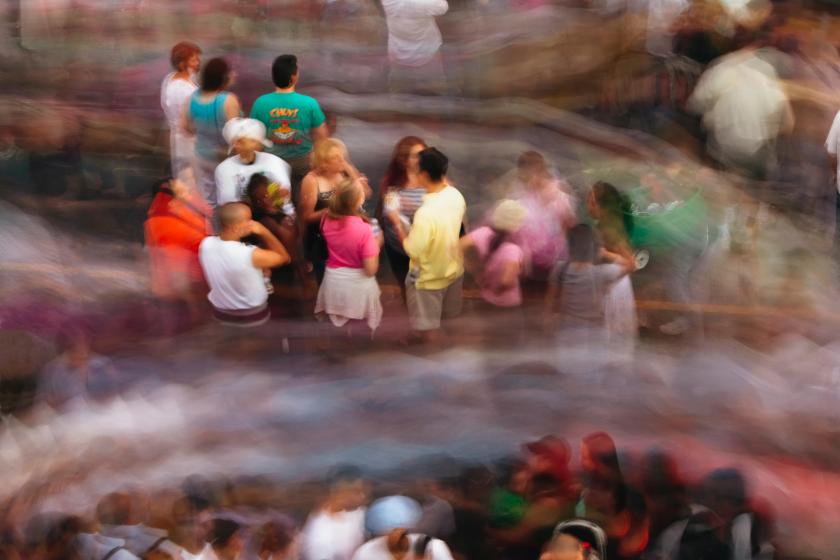Crowd analytics provides a way for sports teams to manage traffic flow around large facilities. It can also help other organizations do the same in settings such as airports, shopping malls, and hospitals.
Increasingly, the key to enabling crowd analytics is 5G networking, which makes the bandwidth possible to reduce latency at the edge.
“The fast connectivity and low latency enable real-time decisions around crowd data for stadium operators,” explains Rich Karpinski, principal analyst at 451 Research, a division of S&P Global Market Intelligence.
Sports leagues like the NHL use 5G and mobile edge computing (MEC) to improve operations around the stadium and boost the fan experience. In addition, Verizon offers 5G Ultra Wideband in some NBA arenas and 30 NFL stadiums as well.
Although Verizon wouldn’t provide specifics on which organizations are using crowd analytics, teams like the Phoenix Suns use Verizon 5G and MEC to enhance the fan experience with multiple camera angles.
A goal for companies such as Verizon is to address security, staffing, and traffic flow concerns of facilities operators, according to Jason Stevens, technical operational manager at Verizon. For example, facility operators can use the crowd analytics data to detect bottlenecks and direct traffic flow around a problem such as a broken escalator.
Crowd analytics allows stadium operators to get real time or near-real-time data on incidents in the crowd and open new lines of foot traffic as needed, Karpinski explains.
“For historical analysis, feeding all of that data into some sort of learning environment that can adapt over time and maybe provide recommendations about how to optimize for traffic is going to be real important,” Karpinski says.
How Crowd Analytics Works
Verizon’s turnkey 5G Edge Crowd Analytics solution incorporates CrowdVision advanced indoor analytics and AWS Wavelength, which offers the compute environment at the edge to allow IT leaders at large facilities to run apps that require ultra-low latency.
Karpinski expects venues to install a crowd analytics solution over a private shared network.
“I think in many of these cases, 5G is going to be deployed on a private network so you're going to get that dedicated bandwidth to support the application,” Karpinski says. “You also can get integrated edge compute, which would be very important to help analyze the data. So, I think 5G and edge are a big enabler of crowd analytics.”
The Verizon technology incorporates sensors to study traffic flow data and crowd behavior and enables facilities to improve crowd safety and better manage crowd movement.
5G Edge Crowd Analytics also incorporates Ouster 360-degree Light Detection and Ranging (LiDAR), which are light-emitting array sensors on a wall or ceiling.
“They provide basically a 360-degree level of measurement around that sensor,” Stevens says. “Then we're able to train the AI on the back end of the AI side of the LiDAR to look for what are essentially human signatures in that environment looking for individuals.”
SkyFi provides a machine-learning compute layer as part of the Edge Crowd Analytics solution. The LiDARs connect to a fixed wireless access (FWA) appliance. Stevens also says the solution uses cellular technology rather than requiring traditional circuits.
“LiDAR is just basically another kind of camera with built-in anonymity, so you're going to get a little lower bandwidth requirement because you're not pulling in full video streams,” Karpinski says. “And you're also not as worried about anonymity because you're really not pulling in likenesses, and it's a good technology for these kinds of applications.”
Verizon has tested the Edge Crowd Analytics solution in the cafeteria in its Basking Ridge, New Jersey, headquarters. Stevens showed Network Computing a demo of recorded footage on a dashboard showing heat maps of blue dots, which signify congestion points and flow patterns in the cafeteria. Verizon also has deployed Edge Crowd Analytics at the Ridge Hotel, which adjoins the company’s offices in Basking Ridge.
Stadiums, airports, hospitals, and retail operators can glean data from similar dashboards, according to Stevens.
“It gives them the ability to really understand how people are entering my different environments, where are they going, and how much time they are spending in different locations,” Stevens explains.
Verizon company executives use the data to help facilities operators and food service teams manage inventory of food items. The company also uses LiDAR to track the flow of traffic to the Starbucks location at its headquarters, according to Stevens.
“When we think about our own global real estate team, our premise-based security team, there's a wealth of data they're able to pull from this technology that is used to improve our facility operations,” he says.
Stevens says an NFL or MBA team can incorporate these capabilities into a mobile app to track occupancy at food service counters and restrooms. Theaters could use crowd analytics technology as well.
“Maybe you operate a large theater, and you have certain rooms that have fire safety occupancy limits. This technology can help you understand proactively if you have a room that's only supposed to have 50 people in it,” Stevens says.
Managing Privacy Concerns in Crowd Analytics
Stevens explains that the LiDAR is anonymized so as not to capture the identities of spectators.
“The beauty of LiDAR is its anonymized data,” Stevens says. “It’s just light-emitting rays, so we’re not capturing identities.”
Karpinski recommends that businesses have an up-front policy on anonymity when implementing a crowd analytics solution. “In a crowd, generally, if it's not an immediate issue like violence or a fight, I would anonymize the data,” Karpinski says. “There’s really no need to share that kind of data about individuals and where they are."
Instead, sports teams can get more data about fans through programs such as loyalty cards, he says.
“There are places where people have to recognize they're not fully private in public, but there are going to be other times when someone has paid for access to a stadium or a game, for instance,” Karpinski says. “Then there's more of a relationship where there are customer expectations to keep an account.”
A Phased Approach to Crowd Analytics
Stevens recommends a “crawl, walk, run” phased approach when implementing crowd analytics.
“Let's say you own a large stadium, well, you're probably not going to want to jump in the deep end of the pool and install 1,000 LiDAR sensors across your entire stadium all at once,” Stevens says.
Instead, a phased approach allows organizations to introduce the technology to their staff and train them on how to leverage the data to boost operations. For a stadium, that may mean starting in the VIP lounge, and an airport may first implement crowd analytics in one terminal to start, Stevens says.
When venue operators start small, they can measure their ROI and evaluate the next steps as they get comfortable with the technology.
By using crowd analytics to manage traffic flow and speed up fan entry into the stadium, stadium operators will get fans spending money faster, like at the concession stands or in the souvenir store, Stevens says.
The 5G connectivity will enable stadium operators to connect sensors and cameras and gain speed, but additional benefits will come later, according to Karpinski.
“Over time, as more of the intelligence of 5G is enabled, whether it's access to the network via APIs, dedicating a network slice specifically to this kind of an application, a more intelligent 5G network will be able to make crowd analytics all that more powerful,” he says.
Related articles:









